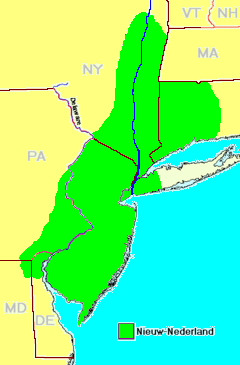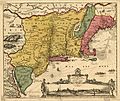New Netherland settlements facts for kids
New Netherland (called Nieuw-Nederland in Dutch) was a special area in North America during the 1600s. It was a colony of the Republic of the Seven United Netherlands, which is now the Netherlands. This colony was located on the northeastern coast of North America.
The Dutch claimed land from the Delmarva Peninsula all the way up to southern Cape Cod. Today, these settled areas are part of the states of New York, New Jersey, and Delaware. There were also small Dutch outposts in Connecticut and Pennsylvania. The main city, called New Amsterdam, was built at the very tip of Manhattan island, right on the Upper New York Bay.
An explorer named Henry Hudson first explored this region in 1609. He was on a trip for the Dutch East India Company. Later, the area was mapped out and given the name New Netherland in 1614. The Dutch gave new names to the three main rivers in the area. They called the Delaware River the Zuyd Rivier (South River). The Hudson River was called the Noort Rivier (North River). And the Connecticut River was named the Versche Rivier (Fresh River). The Dutch wanted to use these rivers to travel inland and trade with the local people, especially for valuable fur.
To officially claim land, countries needed to explore it, map it, and then settle it. The Dutch decided not to send huge numbers of settlers at first. Instead, they set up "factories" (which were like trading posts with a small military group and a few people to support them). This was a successful way they had done things in Asia. This time was known as the Dutch Golden Age, even though there were wars happening in Europe. It was hard to convince people to leave the good economy and exciting culture of Europe to move to the new colony.
The Dutch West India Company managed the colony, but they often didn't have enough money or good plans. This made early settlement difficult. There were also many misunderstandings and fights with the Native Americans. But things got much better in the 1650s. The Dutch allowed more trade, gave the colonists some say in their own rules, and lost their colony in Dutch Brazil. This led to a big increase in people moving to New Netherland. When power was transferred from the Netherlands to England, it happened peacefully. The final transfer was made official in 1674.
Contents
Early Trading Posts and Forts
The Dutch built their first Fort Nassau in the land of the Mahican people. This was one of the first places where they traded with Native Americans. They also set up many small trading posts, called factorijen, in places like Schenectady, Schoharie, Esopus, and others. A trapper named Jan Rodrigues is thought to be the first non-Native American to spend a winter on Manhattan island in 1613.
Building a Capital City
In 1621, the Dutch West India Company was given the sole right to trade in the New Netherland region by the Dutch government. By 1624, New Netherland officially became a province of the Dutch Republic. At first, the South River was chosen for the capital because people thought it had the best weather. But the hot, humid summers, many mosquitos, and freezing winters made the North River area seem better.
Many ships brought settlers to the New World. They first arrived at Noten Island and then moved to the tip of Manhattan. Here, they began building Fort Amsterdam, and the colony started to grow around it. Some early groups were sent to other places like Fort Orange, but many were later called back to the main settlement. Among these first settlers were many Walloons (people from a part of Belgium) and 11 Africans who were brought as company-owned slaves.
The Patroon System
In 1629, the Dutch West India Company created a system called the patroon system. This system offered big land grants and special rights, almost like a lord in old Europe, to people who would bring and settle at least 50 new colonists. Many tried this, but the only big success was the Manor of Rensselaerswyck. This large area was owned by Kiliaen van Rensselaer.
A place called Pavonia, which was across the river from New Amsterdam, was given back to the company and managed by them. In 1640, the company changed its rules. This allowed regular people to buy land if they were in good standing.
Settlements on the South River
Another patroon attempt was the Zwaanendael Colony, located on the Zuyd Rivier (Delaware Bay). This was the first Dutch settlement in that area, founded in 1631. However, it was attacked and destroyed soon after it was built. After 1638, most of the settlement in this region was part of New Sweden. But in 1655, the Dutch took control of these areas when they built Fort Casimir. Later, in 1663, a man named Pieter Corneliszoon Plockhoy tried to start a special community there, but it ended when the English took over.
Settlements on the Fresh River (Connecticut)
The Dutch also set up a short-lived trading post called Kievits Hoek (or Plover's Corner) in what is now Old Saybrook, Connecticut. They soon left it to focus on a trading post at Fort Goede Hoop on the Connecticut River, which was finished in 1633. The Dutch also had a trading post and possibly a fort at the mouth of the Branford River in Branford, Connecticut.
Soon after, English settlers from the Massachusetts Bay Colony formed the Connecticut Colony in 1636, and the New Haven Colony in 1638. Petrus Stuyvesant, the Dutch leader, tried to stop the English from taking more land. He agreed to a border 50 miles west of the river in the Treaty of Hartford (1650). But this didn't stop more English people from moving to Long Island and the mainland along Long Island Sound.
Life on the North River
The port city known as the Manhattans grew at the mouth of the North River (Hudson River). New Amsterdam was the capital of New Netherland. It received its official city charter in 1652. This city included Manhattan island, Staaten Eylandt, Pavonia, and the towns on Lange Eylandt, such as Gravesend, Breuckelen, and Nieuw Amersfoort.
Another important city was Beverwijck, which also got a city charter in 1652. It had grown from a trading post into a busy town within the large Rensselaerswyck area. In 1657, the scattered homes along the west bank of the Hudson Valley in Esopus were told to build a fort. This fort grew into the province's third-largest town, Wiltwijk.
The Dutch Belt
After the English officially took over New Netherland with the Treaty of Westminster (1674), Dutch settlers continued to spread out across the region. They established many of the towns and cities that still exist today. The Dutch Reformed Church played a very important role in this expansion. Settlers followed the Hudson River north from New York Harbor and also moved south along the Raritan River. George Washington later called this area the "Dutch Belt."
Population Growth
Here are some estimates of how many people lived in New Netherland (not including Native Americans):
- 1628: 270 people
- 1630: 300 people
- 1640: 500 people
- 1650: 800 - 1,000 people
- 1664: 9,000 people
Images for kids
-
(c. 1629) Fort Orange and Castle Island
-
Manatus Map (c. 1639) Manhattan situated on the North Rivier
-
Nautical chart of Zwaanendael, 1639








